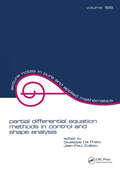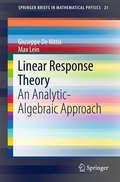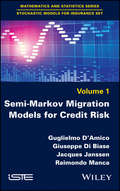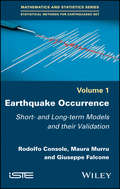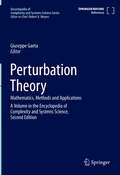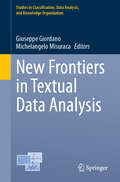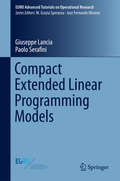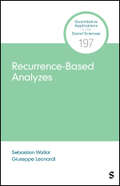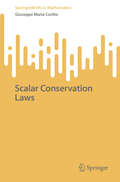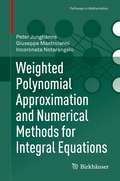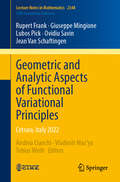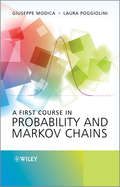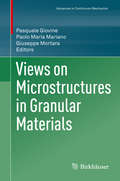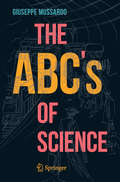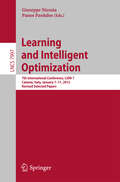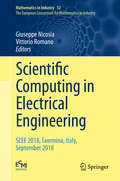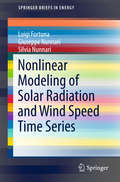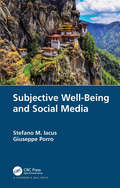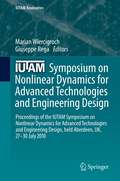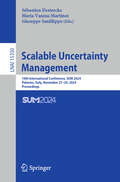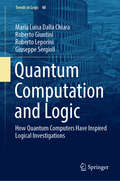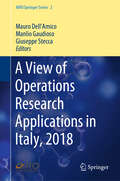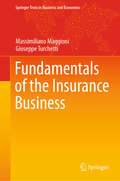- Table View
- List View
partial differential equation methods in control and shape analysis: lecture notes in pure and applied mathematics (Lecture Notes in Pure and Applied Mathematics)
by Giuseppe Da Prato Jean-Paul Zolésio"Based on the International Federatiojn for Information Processing WG 7.2 Conference, held recently in Pisa, Italy. Provides recent results as well as entirely new material on control theory and shape analysis. Written by leading authorities from various desciplines."
Linear Response Theory
by Giuseppe De Nittis Max LeinThis book presents a modern and systematic approach to Linear Response Theory (LRT) by combining analytic and algebraic ideas. LRT is a tool to study systems that are driven out of equilibrium by external perturbations. In particular the reader is provided with a new and robust tool to implement LRT for a wide array of systems. The proposed formalism in fact applies to periodic and random systems in the discrete and the continuum. After a short introduction describing the structure of the book, its aim and motivation, the basic elements of the theory are presented in chapter 2. The mathematical framework of the theory is outlined in chapters 3-5: the relevant von Neumann algebras, noncommutative $L^p$- and Sobolev spaces are introduced; their construction is then made explicit for common physical systems; the notion of isopectral perturbations and the associated dynamics are studied. Chapter 6 is dedicated to the main results, proofs of the Kubo and Kubo-Streda formulas. The book closes with a chapter about possible future developments and applications of the theory to periodic light conductors. The book addresses a wide audience of mathematical physicists, focusing on the conceptual aspects rather than technical details and making algebraic methods accessible to analysts.
Semi-Markov Migration Models for Credit Risk
by Jacques Janssen Raimondo Manca Giuseppe Di Biase Guglielmo D'AmicoCredit risk is one of the most important contemporary problems for banks and insurance companies. Indeed, for banks, more than forty percent of the equities are necessary to cover this risk. Though this problem is studied by large rating agencies with substantial economic, social and financial tools, building stochastic models is nevertheless necessary to complete this descriptive orientation.This book presents a complete presentation of such a category of models using homogeneous and non-homogeneous semi-Markov processes developed by the authors in several recent papers. This approach provides a good method of evaluating the default risk and the classical VaR indicators used for Solvency II and Basel III governance rules.This book is the first to present a complete semi-Markov treatment of credit risk while also insisting on the practical use of the models presented here, including numerical aspects, so that this book is not only useful for scientific research but also to managers working in this field for banks, insurance companies, pension funds and other financial institutions.
Earthquake Occurrence: Short- and Long-term Models and their Validation
by Giuseppe Falcone Maura Murru Rodolfo ConsoleEarthquake Occurrence provides the reader with a review of algorithms applicable for modeling seismicity, such as short-term earthquake clustering and pseudo-periodic long-term behavior of major earthquakes. The concept of the likelihood ratio of a set of observations under different hypotheses is applied for comparison among various models. In short-term models, known by the term ETAS, the occurrence space and time rate density of earthquakes is modeled as the sum of two terms, one representing the independent or spontaneous events, and the other representing the activity triggered by previous earthquakes. Examples of the application of such algorithms in real cases are also reported. Dealing with long-term recurrence models, renewal time-dependent models, implying a pseudo-periodicity of earthquake occurrence, are compared with the simple time-independent Poisson model, in which every event occurs regardless of what has occurred in the past. The book also introduces a number of computer codes developed by the authors over decades of seismological research.
Perturbation Theory: Mathematics, Methods and Applications (Encyclopedia of Complexity and Systems Science Series)
by Giuseppe GaetaThis volume in the Encyclopedia of Complexity and Systems Science, Second Edition, is devoted to the fundamentals of Perturbation Theory (PT) as well as key applications areas such as Classical and Quantum Mechanics, Celestial Mechanics, and Molecular Dynamics. Less traditional fields of application, such as Biological Evolution, are also discussed. Leading scientists in each area of the field provide a comprehensive picture of the landscape and the state of the art, with the specific goal of combining mathematical rigor, explicit computational methods, and relevance to concrete applications. New to this edition are chapters on Water Waves, Rogue Waves, Multiple Scales methods, legged locomotion, Condensed Matter among others, while all other contributions have been revised and updated. Coverage includes the theory of (Poincare’-Birkhoff) Normal Forms, aspects of PT in specific mathematical settings (Hamiltonian, KAM theory, Nekhoroshev theory, and symmetric systems), technical problems arising in PT with solutions, convergence of series expansions, diagrammatic methods, parametric resonance, systems with nilpotent real part, PT for non-smooth systems, and on PT for PDEs [write out this acronym partial differential equations]. Another group of papers is focused specifically on applications to Celestial Mechanics, Quantum Mechanics and the related semiclassical PT, Quantum Bifurcations, Molecular Dynamics, the so-called choreographies in the N-body problem, as well as Evolutionary Theory. Overall, this unique volume serves to demonstrate the wide utility of PT, while creating a foundation for innovations from a new generation of graduate students and professionals in Physics, Mathematics, Mechanics, Engineering and the Biological Sciences.
New Frontiers in Textual Data Analysis (Studies in Classification, Data Analysis, and Knowledge Organization)
by Michelangelo Misuraca Giuseppe GiordanoThis volume presents a selection of articles which explore methodological and applicative aspects of textual data analysis. Divided into four parts, it begins by focusing on statistical methods, and then moves on to problems in quantitative language processing. After discussing the challenging task of text mining in relation to emotional and sentiment analyses, the book concludes with a collection of studies in the social sciences and public health which apply textual data analysis methods.The refereed contributions were originally presented at the 16th International Conference on Statistical Analysis of Textual Data (JADT 2022), which took place in Naples, Italy, on July 6-8, 2022. The biennial JADT meeting discusses theories, problems, and practical uses of textual data analysis in various fields, sharing a quantitative approach to the study of lexical, textual, pragmatic or discursive features of information expressed in natural language.
Compact Extended Linear Programming Models (EURO Advanced Tutorials on Operational Research)
by Giuseppe Lancia Paolo SerafiniThis book provides a handy, unified introduction to the theory of compact extended formulations of exponential-size integer linear programming (ILP) models. Compact extended formulations are equally powerful, but polynomially-sized, models whose solutions do not require the implementation of separation and pricing procedures. The book is written in a general, didactic, form first developing the background theoretical concepts (polyhedra, projections, linear and integer programming) and then delving into the various techniques for compact extended reformulations. The techniques are illustrated through a wealth of examples touching on many application areas, such as classical combinatorial optimization, network design, timetabling, scheduling, routing, computational biology and bioinformatics. The book is intended for graduate or PhD students - either as an advanced course on selected topics or within a more general course on ILP and Mathematical Programming - as well as for practitioners and software engineers in industry looking at techniques for developing optimization models for their specific problems.
Recurrence-Based Analyses (Quantitative Applications in the Social Sciences)
by Sebastian Wallot Giuseppe LeonardiThis book introduces techniques developed in physics and physiology for characterizing and analyzing patterns in time series data to a broad audience of social scientists. In contrast to time-series regression and related techniques, recurrence quantification analysis (RQA) has its background in chaos and nonlinear dynamical systems—theory arguably very relevant to social processes. The goal of Recurrence-Based Analyses is to introduce readers to these techniques that can characterize a system’s complexity, stability and instability, and conditions under which it transitions from one state to another. The authors illustrate concepts and techniques with relevant social science examples at different temporal scales: biweekly polling data on federal elections in Germany; daily values of three stock market indices; daily cases of SarsCov-19 in four countries during the pandemic; and second-by-second vocalizations of mothers and infants interacting recorded by motion cameras. This introduction to RQA serves as a useful supplement to undergraduate and graduate courses in computational social science, and also by researchers who seek new tools to address social scientific questions in new ways.
Recurrence-Based Analyses (Quantitative Applications in the Social Sciences)
by Sebastian Wallot Giuseppe LeonardiThis book introduces techniques developed in physics and physiology for characterizing and analyzing patterns in time series data to a broad audience of social scientists. In contrast to time-series regression and related techniques, recurrence quantification analysis (RQA) has its background in chaos and nonlinear dynamical systems—theory arguably very relevant to social processes. The goal of Recurrence-Based Analyses is to introduce readers to these techniques that can characterize a system’s complexity, stability and instability, and conditions under which it transitions from one state to another. The authors illustrate concepts and techniques with relevant social science examples at different temporal scales: biweekly polling data on federal elections in Germany; daily values of three stock market indices; daily cases of SarsCov-19 in four countries during the pandemic; and second-by-second vocalizations of mothers and infants interacting recorded by motion cameras. This introduction to RQA serves as a useful supplement to undergraduate and graduate courses in computational social science, and also by researchers who seek new tools to address social scientific questions in new ways.
Scalar Conservation Laws (SpringerBriefs in Mathematics)
by Giuseppe Maria CocliteThis book are notes prepared for the PhD courses that the author has been teaching during the last 10 years. The material available in the already existing literature (papers and essays) has been collected in this unique text, presenting the results with all the details for the reader’s convenience, fixing a unified notation, and providing a consistent framework for the subject. These notes cover many of the arguments that usually can be found in high level essays, where the proofs are simply sketched, and in papers, which are not easily available and not always self-contained.This book is intended for1. PhD students in Mathematics, Physics and Mechanical Engineering in order to learn the basic features of nonlinear scalar equations,2. researchers interested in nonlinear hyperbolic PDEs in order to learn the details behind some known and deep results on nonlinear scalar equations,3. teachers of courses on nonlinear PDEs.The readers are expected to know the basic measure theory and Sobolev spaces.
Weighted Polynomial Approximation and Numerical Methods for Integral Equations (Pathways in Mathematics)
by Giuseppe Mastroianni Peter Junghanns Incoronata NotarangeloThe book presents a combination of two topics: one coming from the theory of approximation of functions and integrals by interpolation and quadrature, respectively, and the other from the numerical analysis of operator equations, in particular, of integral and related equations.The text focusses on interpolation and quadrature processes for functions defined on bounded and unbounded intervals and having certain singularities at the endpoints of the interval, as well as on numerical methods for Fredholm integral equations of first and second kind with smooth and weakly singular kernel functions, linear and nonlinear Cauchy singular integral equations, and hypersingular integral equations.The book includes both classic and very recent results and will appeal to graduate students and researchers who want to learn about the approximation of functions and the numerical solution of operator equations, in particular integral equations.
Geometric and Analytic Aspects of Functional Variational Principles: Cetraro, Italy 2022 (Lecture Notes in Mathematics #2348)
by Giuseppe Mingione Rupert Frank Lubos Pick Ovidiu Savin Jean Van SchaftingenThis book is dedicated to exploring optimization problems of geometric-analytic nature, which are fundamental to tackling various unresolved questions in mathematics and physics. These problems revolve around minimizing geometric or analytic quantities, often representing physical energies, within prescribed collections of sets or functions. They serve as catalysts for advancing methodologies in calculus of variations, partial differential equations, and geometric analysis. Furthermore, insights from optimal functional-geometric inequalities enhance analytical problem-solving endeavors. The contributions focus on the intricate interplay between these inequalities and problems of differential and variational nature. Key topics include functional and geometric inequalities, optimal norms, sharp constants in Sobolev-type inequalities, and the regularity of solutions to variational problems. Readers will gain a comprehensive understanding of these concepts, deepening their appreciation for their relevance in mathematical and physical inquiries.
A First Course in Probability and Markov Chains
by Giuseppe Modica Laura PoggioliniProvides an introduction to basic structures of probability with a view towards applications in information technology A First Course in Probability and Markov Chains presents an introduction to the basic elements in probability and focuses on two main areas. The first part explores notions and structures in probability, including combinatorics, probability measures, probability distributions, conditional probability, inclusion-exclusion formulas, random variables, dispersion indexes, independent random variables as well as weak and strong laws of large numbers and central limit theorem. In the second part of the book, focus is given to Discrete Time Discrete Markov Chains which is addressed together with an introduction to Poisson processes and Continuous Time Discrete Markov Chains. This book also looks at making use of measure theory notations that unify all the presentation, in particular avoiding the separate treatment of continuous and discrete distributions.A First Course in Probability and Markov Chains:Presents the basic elements of probability.Explores elementary probability with combinatorics, uniform probability, the inclusion-exclusion principle, independence and convergence of random variables. Features applications of Law of Large Numbers. Introduces Bernoulli and Poisson processes as well as discrete and continuous time Markov Chains with discrete states. Includes illustrations and examples throughout, along with solutions to problems featured in this book. The authors present a unified and comprehensive overview of probability and Markov Chains aimed at educating engineers working with probability and statistics as well as advanced undergraduate students in sciences and engineering with a basic background in mathematical analysis and linear algebra.
Views on Microstructures in Granular Materials (Advances in Mechanics and Mathematics #44)
by Paolo Maria Mariano Pasquale Giovine Giuseppe MortaraThis contributed volume provides an up-to-date overview of the mechanics of granular materials, ranging from sparse media to soils. With chapters exploring state-of-the-art theoretical, experimental, and applied trends in the study of granular matter in various states, readers will be motivated to learn about the current challenges and potential avenues of exploration in this active area of research. Including a variety of perspectives, this volume will be a valuable reference for audiences in a number of fields. Specific topics covered include:X-ray tomography techniques for analyzing sandEvaluation of effective stress in unsaturated soilsHyper-plasticityWave propagation in granular systemsPartly saturated porous mediaMulti-scale approaches to the dynamics of sparse mediaViews on Microstructures in Granular Materials is an ideal resource for PhD students and researchers in applied mathematics, solid-state physics, civil engineering, and mechanical engineering.
The ABC’s of Science
by Giuseppe MussardoScience, with its inherent tension between the known and the unknown, is an inexhaustible mine of great stories. Collected here are twenty-six among the most enchanting tales, one for each letter of the alphabet: the main characters are scientists of the highest caliber most of whom, however, are unknown to the general public.This book goes from A to Z. The letter A stands for Abel, the great Norwegian mathematician, here involved in an elliptic thriller about a fundamental theorem of mathematics, while the letter Z refers to Absolute Zero, the ultimate and lowest temperature limit, - 273,15 degrees Celsius, a value that is tremendously cooler than the most remote corner of the Universe: the race to reach this final outpost of coldness is not yet complete, but, similarly to the history books of polar explorations at the beginning of the 20th century, its pages record successes, failures, fierce rivalries and tragic desperations. In between the A and the Z, the other letters of the alphabet are similar to the various stages of a very fascinating journey along the paths of science, a journey in the company of a very unique set of characters as eccentric and peculiar as those in Ulysses by James Joyce: the French astronomer who lost everything, even his mind, to chase the transits of Venus; the caustic Austrian scientist who, perfectly at ease with both the laws of psychoanalysis and quantum mechanics, revealed the hidden secrets of dreams and the periodic table of chemical elements; the young Indian astrophysicist who was the first to understand how a star dies, suffering the ferocious opposition of his mentor for this discovery. Or the Hungarian physicist who struggled with his melancholy in the shadows of the desert of Los Alamos; or the French scholar who was forced to hide her femininity behind a false identity so as to publish fundamental theorems on prime numbers. And so on and so forth.Twenty-six stories, which reveal the most authentic atmosphere of science and the lives of some of its main players: each story can be read in quite a short period of time -- basically the time it takes to get on and off the train between two metro stations. Largely independent from one another, these twenty-six stories make the book a harmonious polyphony of several voices: the reader can invent his/her own very personal order for the chapters simply by ordering the sequence of letters differently. For an elementary law of Mathematics, this can give rise to an astronomically large number of possible books -- all the same, but - then again - all different. This book is therefore the ideal companion for an infinite number of real or metaphoric journeys.
Learning and Intelligent Optimization
by Panos Pardalos Giuseppe NicosiaThis book constitutes the proceedings of the 7th International Conference on Learning and Optimization, LION 7, which was held in Catania, Italy, in January 2013. The 49 contributions presented in this volume were carefully reviewed and selected from 101 submissions. They explore the intersections and uncharted territories between machine learning, artificial intelligence, mathematical programming and algorithms for hard optimization problems.
Scientific Computing in Electrical Engineering: SCEE 2018, Taormina, Italy, September 2018 (Mathematics in Industry #32)
by Giuseppe Nicosia Vittorio RomanoThis collection of selected papers presented at the 12th International Conference on Scientific Computing in Electrical Engineering, SCEE 2018, held in Taormina, Sicily, Italy, in September 2018, showcases the state of the art in SCEE.The aim of the SCEE 2018 conference was to bring together scientists from academia and industry, mathematicians, electrical engineers, computer scientists, and physicists, and to promote intensive discussions on industrially relevant mathematical problems, with an emphasis on the modeling and numerical simulation of electronic circuits and of electromagnetic fields. This extensive reference work is divided into five parts: Computational Electromagnetics, Device Modeling and Simulation, Circuit Simulation, Mathematical and Computational Methods, Model Order Reduction. Each part starts with a general introduction, followed by the respective contributions. The book will appeal to mathematicians and electrical engineers. Further, it introduces algorithm and program developers to recent advances in the other fields, while industry experts will be introduced to new programming tools and mathematical methods.
Nonlinear Modeling of Solar Radiation and Wind Speed Time Series
by Luigi Fortuna Giuseppe Nunnari Silvia NunnariThis brief is a clear, concise description of the main techniques of time series analysis --stationary, autocorrelation, mutual information, fractal and multifractal analysis, chaos analysis, etc. -- as they are applied to the influence of wind speed and solar radiation on the production of electrical energy from these renewable sources. The problem of implementing prediction models is addressed by using the embedding-phase-space approach: a powerful technique for the modeling of complex systems. Readers are also guided in applying the main machine learning techniques for classification of the patterns hidden in their time series and so will be able to perform statistical analyses that are not possible by using conventional techniques. The conceptual exposition avoids unnecessary mathematical details and focuses on concrete examples in order to ensure a better understanding of the proposed techniques. Results are well-illustrated by figures and tables.
Cyber Security, Cryptology, and Machine Learning: 8th International Symposium, CSCML 2024, Be'er Sheva, Israel, December 19–20, 2024, Proceedings (Lecture Notes in Computer Science #15349)
by Giuseppe Persiano Shlomi Dolev Mirosław Kutyłowski Michael ElhadadThis book constitutes the proceedings of the 8th International Symposium on Cyber Security, Cryptology, and Machine Learning, CSCML 2024, held in Be'er Sheva, Israel, during December 19–20, 2024. The 16 full papers and 11 short papers presented here were carefully reviewed and selected from 43 submissions. These papers focus on the current innovative research developments in the field of cyber security, cryptography, and machine learning systems and networks.
Subjective Well-Being and Social Media
by Stefano M. Iacus Giuseppe PorroSubjective Well-Being and Social Media shows how, by exploiting the unprecedented amount of information provided by the social networking sites, it is possible to build new composite indicators of subjective well-being. These new social media indicators are complementary to official statistics and surveys, whose data are collected at very low temporary and geographical resolution. The book also explains in full details how to solve the problem of selection bias coming from social media data. Mixing textual analysis, machine learning and time series analysis, the book also shows how to extract both the structural and the temporary components of subjective well-being. Cross-country analysis confirms that well-being is a complex phenomenon that is governed by macroeconomic and health factors, ageing, temporary shocks and cultural and psychological aspects. As an example, the last part of the book focuses on the impact of the prolonged stress due to the COVID-19 pandemic on subjective well-being in both Japan and Italy. Through a data science approach, the results show that a consistent and persistent drop occurred throughout 2020 in the overall level of well-being in both countries. The methodology presented in this book: enables social scientists and policy makers to know what people think about the quality of their own life, minimizing the bias induced by the interaction between the researcher and the observed individuals; being language-free, it allows for comparing the well-being perceived in different linguistic and socio-cultural contexts, disentangling differences due to objective events and life conditions from dissimilarities related to social norms or language specificities; provides a solution to the problem of selection bias in social media data through a systematic approach based on time-space small area estimation models. The book comes also with replication R scripts and data. Stefano M. Iacus is full professor of Statistics at the University of Milan, on leave at the Joint Research Centre of the European Commission. Former R-core member (1999-2017) and R Foundation Member. Giuseppe Porro is full professor of Economic Policy at the University of Insubria. An earlier version of this project was awarded the Italian Institute of Statistics-Google prize for "official statistics and big data".
IUTAM Symposium on Nonlinear Dynamics for Advanced Technologies and Engineering Design
by Giuseppe Rega Marian WiercigrochNonlinear dynamics has been enjoying a vast development for nearly four decades resulting in a range of well established theory, with the potential to significantly enhance performance, effectiveness, reliability and safety of physical systems as well as offering novel technologies and designs. By critically appraising the state-of-the-art, it is now time to develop design criteria and technology for new generation products/processes operating on principles of nonlinear interaction and in the nonlinear regime, leading to more effective, sensitive, accurate, and durable methods than what is currently available. This new approach is expected to radically influence the design, control and exploitation paradigms, in a magnitude of contexts. With a strong emphasis on experimentally calibrated and validated models, contributions by top-level international experts will foster future directions for the development of engineering technologies and design using robust nonlinear dynamics modelling and analysis.
Scalable Uncertainty Management: 16th International Conference, SUM 2024, Palermo, Italy, November 27–29, 2024, Proceedings (Lecture Notes in Computer Science #15350)
by Maria Vanina Martinez Sébastien Destercke Giuseppe SanfilippoThis book constitutes the refereed proceedings of the 16th International Conference on Scalable Uncertainty Management, SUM 2024, held in Palermo, Italy, during November 27–29, 2024. The 28 full and 7 short papers presented in this volume were carefully reviewed and selected from 43 submissions. SUM 2024 solicited three types of paper submissions: Long papers reporting on original research or providing surveys that synthesize current research trends, short papers describing promising work in progress, systems, or positions on controversial issues, and extended abstracts.
Quantum Computation and Logic: How Quantum Computers Have Inspired Logical Investigations (Trends in Logic #48)
by Maria Luisa Dalla Chiara Roberto Giuntini Roberto Leporini Giuseppe SergioliThis book provides a general survey of the main concepts, questions and results that have been developed in the recent interactions between quantum information, quantum computation and logic. Divided into 10 chapters, the books starts with an introduction of the main concepts of the quantum-theoretic formalism used in quantum information. It then gives a synthetic presentation of the main “mathematical characters” of the quantum computational game: qubits, quregisters, mixtures of quregisters, quantum logical gates. Next, the book investigates the puzzling entanglement-phenomena and logically analyses the Einstein–Podolsky–Rosen paradox and introduces the reader to quantum computational logics, and new forms of quantum logic. The middle chapters investigate the possibility of a quantum computational semantics for a language that can express sentences like “Alice knows that everybody knows that she is pretty”, explore the mathematical concept of quantum Turing machine, and illustrate some characteristic examples that arise in the framework of musical languages. The book concludes with an analysis of recent discussions, and contains a Mathematical Appendix which is a survey of the definitions of all main mathematical concepts used in the book.
A View of Operations Research Applications in Italy, 2018 (AIRO Springer Series #2)
by Mauro Dell’Amico Manlio Gaudioso Giuseppe SteccaThis book presents expert descriptions of the successful application of operations research in both the private and the public sector, including in logistics, transportation, product design, production planning and scheduling, and areas of social interest. Each chapter is based on fruitful collaboration between researchers and companies, and company representatives are among the co-authors. The book derives from a 2017 call by the Italian Operations Research Society (AIRO) for information from members on their activities in promoting the use of quantitative techniques, and in particular operations research techniques, in society and industry. A booklet based on this call was issued for the annual AIRO conference, but it was felt that some of the content was of such interest that it deserved wider dissemination in more detailed form. This book is the outcome. It equips practitioners with solutions to real-life decision problems, offers researchers examples of the practical application of operations research methods, and provides Master’s and PhD students with suggestions for research development in various fields.
Fundamentals of the Insurance Business (Springer Texts in Business and Economics)
by Massimiliano Maggioni Giuseppe TurchettiThis textbook presents the fundamental economic dimensions of insurance companies and links them to managerial issues. Combining academic rigour and a strongly practice-oriented approach, it addresses both the competitive environment and the management of the insurance business. Further, it provides a general overview of insurance undertakings and technical topics are explained in depth. Filling an important gap in the market for textbooks on the insurance business, it is divided into four parts and 35 chapters. Part I (chapters 1 to 10) describes the fundamentals of the business, how the industry works, the Authorities and the regulations. It presents the insurance products (for life, non-life retail, and non-life commercial lines). Part II (chapters 11 to 17) explains the pricing and reserving for life and non-life insurance. Reinsurance business is also illustrated. Part III (chapters 18 to 25) describes business models in the industry and the organizational structures. The main processes of an insurance company (product development, underwriting, claims settlement, investments) are presented. Marketing and distribution are also described. Part IV (chapters 26 to 35) defines the financial statement and introduces IFRS principles. Solvency II calculation, ALM model, and Embedded Value are explained in detail. This part also describes management accounting, performance indicators, and the Business Plan in the insurance industry. The book offers a valuable resource for lower and upper undergraduate students, graduate students, professionals/practitioners working at insurance companies, insurance agents, brokers, bankers, and consultants.
